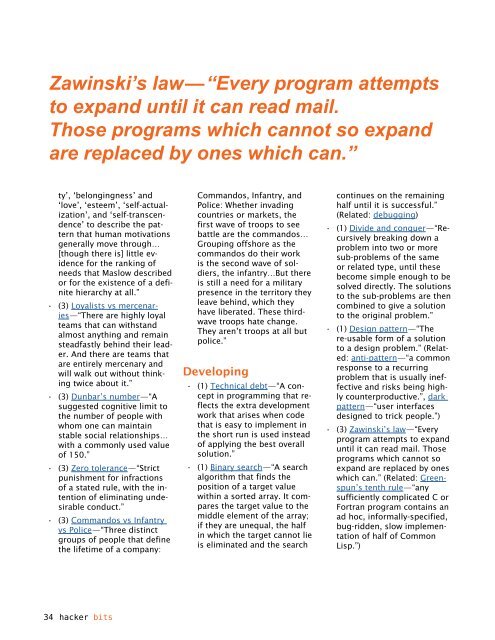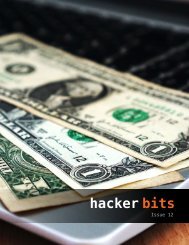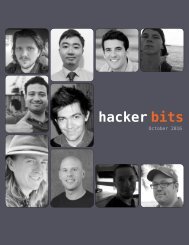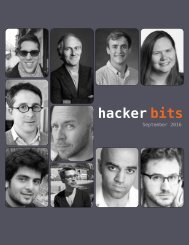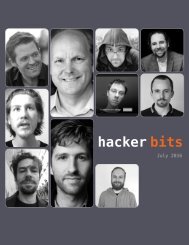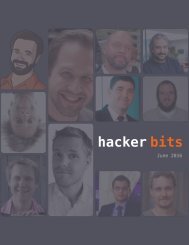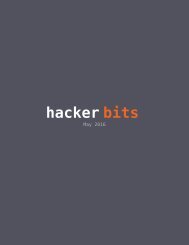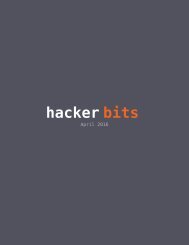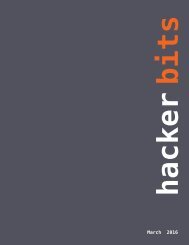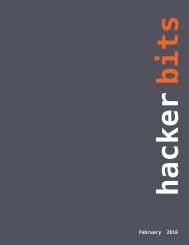Hacker Bits, August 2016
HACKER BITS is the monthly magazine that gives you the hottest technology stories crowdsourced by the readers of Hacker News. We select from the top voted stories and publish them in an easy-to-read magazine format. Get HACKER BITS delivered to your inbox every month! For more, visit https://hackerbits.com/2016-08.
HACKER BITS is the monthly magazine that gives you the hottest technology stories crowdsourced by the readers of Hacker News. We select from the top voted stories and publish them in an easy-to-read magazine format.
Get HACKER BITS delivered to your inbox every month! For more, visit https://hackerbits.com/2016-08.
You also want an ePaper? Increase the reach of your titles
YUMPU automatically turns print PDFs into web optimized ePapers that Google loves.
Zawinski’s law — “Every program attempts<br />
to expand until it can read mail.<br />
Those programs which cannot so expand<br />
are replaced by ones which can.”<br />
ty’, ‘belongingness’ and<br />
‘love’, ‘esteem’, ‘self-actualization’,<br />
and ‘self-transcendence’<br />
to describe the pattern<br />
that human motivations<br />
generally move through…<br />
[though there is] little evidence<br />
for the ranking of<br />
needs that Maslow described<br />
or for the existence of a definite<br />
hierarchy at all.”<br />
• (3) Loyalists vs mercenaries<br />
— “There are highly loyal<br />
teams that can withstand<br />
almost anything and remain<br />
steadfastly behind their leader.<br />
And there are teams that<br />
are entirely mercenary and<br />
will walk out without thinking<br />
twice about it.”<br />
• (3) Dunbar’s number — “A<br />
suggested cognitive limit to<br />
the number of people with<br />
whom one can maintain<br />
stable social relationships…<br />
with a commonly used value<br />
of 150.”<br />
• (3) Zero tolerance — “Strict<br />
punishment for infractions<br />
of a stated rule, with the intention<br />
of eliminating undesirable<br />
conduct.”<br />
• (3) Commandos vs Infantry<br />
vs Police — “Three distinct<br />
groups of people that define<br />
the lifetime of a company:<br />
Commandos, Infantry, and<br />
Police: Whether invading<br />
countries or markets, the<br />
first wave of troops to see<br />
battle are the commandos…<br />
Grouping offshore as the<br />
commandos do their work<br />
is the second wave of soldiers,<br />
the infantry…But there<br />
is still a need for a military<br />
presence in the territory they<br />
leave behind, which they<br />
have liberated. These thirdwave<br />
troops hate change.<br />
They aren’t troops at all but<br />
police.”<br />
Developing<br />
• (1) Technical debt — “A concept<br />
in programming that reflects<br />
the extra development<br />
work that arises when code<br />
that is easy to implement in<br />
the short run is used instead<br />
of applying the best overall<br />
solution.”<br />
• (1) Binary search — “A search<br />
algorithm that finds the<br />
position of a target value<br />
within a sorted array. It compares<br />
the target value to the<br />
middle element of the array;<br />
if they are unequal, the half<br />
in which the target cannot lie<br />
is eliminated and the search<br />
continues on the remaining<br />
half until it is successful.”<br />
(Related: debugging)<br />
• (1) Divide and conquer — “Recursively<br />
breaking down a<br />
problem into two or more<br />
sub-problems of the same<br />
or related type, until these<br />
become simple enough to be<br />
solved directly. The solutions<br />
to the sub-problems are then<br />
combined to give a solution<br />
to the original problem.”<br />
• (1) Design pattern — “The<br />
re-usable form of a solution<br />
to a design problem.” (Related:<br />
anti-pattern — “a common<br />
response to a recurring<br />
problem that is usually ineffective<br />
and risks being highly<br />
counterproductive.”, dark<br />
pattern — “user interfaces<br />
designed to trick people.”)<br />
• (3) Zawinski’s law — “Every<br />
program attempts to expand<br />
until it can read mail. Those<br />
programs which cannot so<br />
expand are replaced by ones<br />
which can.” (Related: Greenspun’s<br />
tenth rule — “any<br />
sufficiently complicated C or<br />
Fortran program contains an<br />
ad hoc, informally-specified,<br />
bug-ridden, slow implementation<br />
of half of Common<br />
Lisp.”)<br />
34 hacker bits


